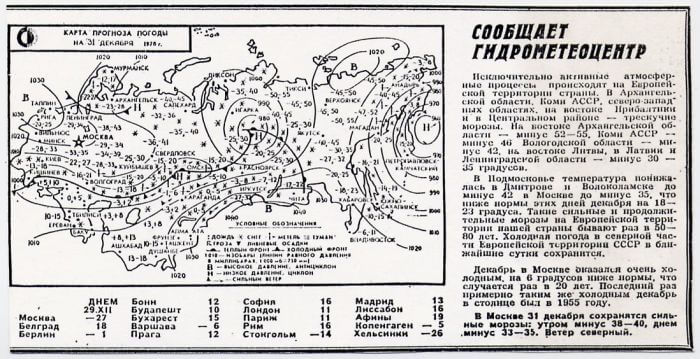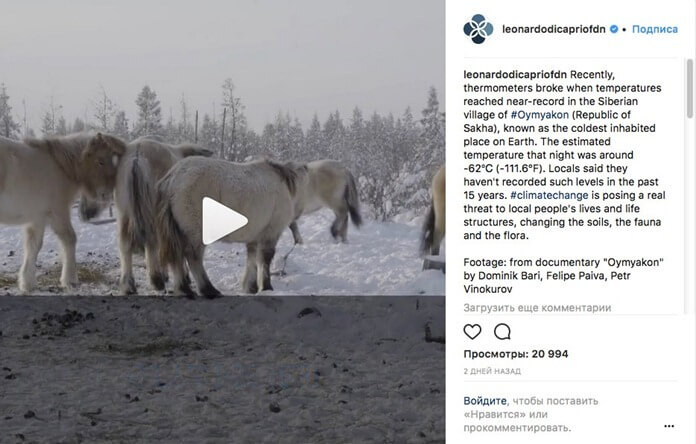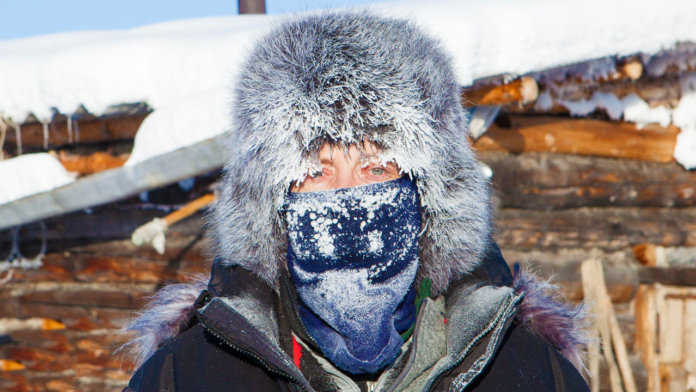It is generally accepted that winter in Russia takes exactly three months. However, in reality the picture is less favorable, since the climatic, and not the calendar, winter lasts 132 days on average.
And if you add to this the cold drizzle of November, you understand that it is not for nothing that foreigners are afraid of Russian winters. And, perhaps, they will be even more scared when they read about the top 10 coldest winters in Russia over the past 100+ years.
10. Winter 2011, temperature: -20 °
Remember T-shirts with the words “I got through winter 2011”? Over the last quarter of a century, it was the winter of 2011 that was the coldest in the Moscow region. And although absolute records were not set this year, for over two months the temperature in the capital was steadily kept below -20 °.
And for the New Year, nature has prepared a "gift" for people - freezing rain, which watered the capital of our country for several days. And then frost hit, the water froze. Under the weight of the ice, trees and power lines still remaining in Moscow began to fall. The Internet was then full of colorful photographs of trees almost completely covered in ice.
9. Winter 2005 -32 °
As a rule, frosts come to the European part of the country when the air currents from the Atlantic Ocean weaken, and they are replaced by winds from Siberia. At this time, the weather is clear, but frosty. The temperature at night drops to minus 25 ° and sometimes even lower, and during the day it rarely exceeds minus 10 °.
Sometimes frosts can last for a very long time - up to two months. This is exactly what happened in Russia in the winter of 2005-2006, when one of the lowest temperatures for the 21st century was recorded.
8. Winter 1919 -36 °
In 1919, Russia was going through hard times. Post-war devastation, civil war, and general poverty. And even the weather seemed to have decided to contribute to human suffering, hitting by abnormal frosts.
As Muscovites wrote in their diaries, the frosts were so strong that even city trams could not function because of the ice accumulated on the wires. And in thirty-degree frosts, residents of the city were forced to get to their workplaces on foot.
It is worth considering that the data on the temperature of the winter of 1919 were taken not from official sources, but from the diaries of people who lived then.
7. Winter 1950 -37 °
Another record winter temperature for the European part of Russia was recorded in January 1950. Surprisingly, it matched the political climate. It was in January 1950 that a decree was adopted restoring the application of the death penalty to traitors to the Motherland and spies.
After the tension of the war years and the indulgences caused by them, the country turned towards tough discipline.
6. Winter 1978 -38.0 °
 But this winter is still remembered by many adult Muscovites. Not only the Russian capital suffered from severe cold weather. Very low temperatures reigned in Russia throughout its European part, from the Urals to the border with Poland, from the Polar Sea to the Volgograd region.
But this winter is still remembered by many adult Muscovites. Not only the Russian capital suffered from severe cold weather. Very low temperatures reigned in Russia throughout its European part, from the Urals to the border with Poland, from the Polar Sea to the Volgograd region.
The record temperature, included in the weather annals, "pleased" the nature of Russians exactly on the New Year's Eve.But life in a big city has its climatic advantages: if in Moscow the temperature reached minus 38 °, then in the region mercury in thermometers dropped to minus 45 °. And we are talking about special meteorological thermometers, because in ordinary household ones, mercury simply froze.
To give you an idea of the scale of the disaster, let us inform you that the average January temperature in the European part of Russia is from minus 10 ° to minus 15 °. And only by January 10, people breathed a sigh of relief - the temperatures returned to the average value.
The cold caused interruptions in communal services: pipes burst from frost, and many high-rise buildings were left without hot water. Some buildings were damaged so badly that residents had to be evacuated. The most interesting thing is that the frosts began quite unexpectedly. As early as December 15, Muscovites enjoyed the relative warmth - the temperature was then + 2.3 °. And at night Santa Claus came and lowered the temperature to -25 °.
5. Winter 1956 -38.1 °
Despite the record low temperatures, Russians and especially Russian women were not particularly frightened by the frost. Many of the women in the pictures are sporting thin nylon tights and ankle-length boots.
But the representatives of the older generation and children are tightly wrapped up from head to toe. It was in the winter of 1955-1956 that the famous series of photographs from Life magazine was taken, depicting the life of Soviet Russia in the mid-50s.
4. Winter 1929 -38.2 °
January 1929 turned out to be cold, but moderate - the temperature did not drop below -25 °. However, frost struck in early February. Colds covered the entire European part of the country, up to the Caucasian subtropics. It was a real disaster for winemaking, as a huge number of vineyards suffered.
And even residents of warm Sochi and the surrounding areas watched with horror the temperature of -10 ° on the thermometers.
3. Winter 1942 -40.1 °
Perhaps, it was precisely due to the abnormally low temperatures of this winter that rumors circulated that the German invaders had been driven out of the territory of the Moscow region by frosts. However, it is not.
Already in December 1941, the enemy was driven back from the walls of Moscow. The soldiers of the Soviet Army greeted the New Year in high spirits; it seemed that the victory over fascism was already very close. In early January, Marshal Shaposhnikov's plan was approved, which included the conduct of large-scale offensive operations along the entire length of the front, from Leningrad to the shores of the Black Sea.
This decision was not well thought out. It remains only to be amazed how, despite the severe frosts, the Soviet troops, having neither a sufficient supply of food nor good roads, liberated a significant territory on the North-Western Front from the enemy.
2. Winter 1892 -41.9 °
The weather service began to exist in Russia in 1872. And it is thanks to her that we can track climatic fluctuations in our country for decades.
Just 20 years after its creation, some of the lowest temperatures in recent years were recorded in the European part of the country, when mercury reached 41 ° and below. Such record cold weather lasted for at least a month.
- For example, the average January temperature in Moscow was then minus 21.6 °, which is even less than that of many cities beyond the Ural ridge.
- The end of December (28th) was marked by frost at minus 39 °,
- and the end of January is minus 41.9 °.
But such cold weather for the late 19th century was by no means something exceptional. For 8 whole years, from 1888 to 1895, Russia was covered by a freezing cold, when the temperature dropped to -30 ° and even less.
1. Winter 1940 -42.2 °
 The coldest winter in the history of Russia over the past hundred years came in 1939-1940. For three months the inhabitants of the European part of the country were constantly freezing. Moreover, the worst frosts in January (record low temperatures were recorded on January 16, 17 and 18, when the thermometer dropped below 42 °) was accompanied by strong winds. Many patients with frostbite were admitted to hospitals.
The coldest winter in the history of Russia over the past hundred years came in 1939-1940. For three months the inhabitants of the European part of the country were constantly freezing. Moreover, the worst frosts in January (record low temperatures were recorded on January 16, 17 and 18, when the thermometer dropped below 42 °) was accompanied by strong winds. Many patients with frostbite were admitted to hospitals.
Severe frosts hit industry and utilities. Enterprises got up, pipes burst, transport stopped running.It became impossible to work on the street, construction and repair work stopped.
In addition to people, nature suffered from the evil frosts. Abnormally low temperatures caused a strong impoverishment of the forests near Moscow, when tree species, less resistant to cold weather, froze out. Thus, oaks and maples almost completely disappeared from the Moscow region. Many fruit trees died in the gardens, even those varieties that people naively considered frost-resistant.
Coldest winter in coldest place in the world - 1924 -71.2 °
The fame of the small village of Oymyakon far exceeds its size. It is here that the Russian Pole of Cold is located - the place where the minimum temperatures around the world.
This is due to the unique location of Oymyakon - the polar latitude, the type of climate (sharply continental) and the height above sea level (the higher, the colder).
The village itself is located in a small horseshoe-shaped depression where cold air flows from the surrounding hills. As a result, in winter temperatures there regularly drop to -60 °. And in 1924 it dropped to -71.2 °.
In 2018, the whole world watched with shudder as children in Oymyakon eat ice cream at a temperature of minus 67 °. Even the Leonardo DiCaprio Foundation on its Instagram expressed horror at such a cold snap in Yakutia (though slightly raising the temperature).

True, he later deleted his post, but the Oymyakon residents responded and even invited them to their place to make sure they were not afraid of the frost. “You’d better come to us,” DiCaprio probably thought.
And if the blood of foreigners, and even many Russians, at such temperatures literally freezes in their veins, for local residents it is just a "slight cold snap." In the place of the club, for example, there is a whole stand dedicated to the health benefits of the Oymyakon air. The main thing is to dress warmly!

